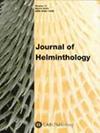法国西南部粗放管理条件下奶山羊胃肠道线虫抗药性的流行情况
IF 1.6
3区 生物学
Q4 PARASITOLOGY
引用次数: 0
摘要
研究人员在法国西南部随机挑选的 18 个奶山羊群中调查了苯并咪唑(BZ)和左旋咪唑抗药性的发生情况,这些奶山羊群的特点是管理粗放。在这 18 个牧场中,每个牧场将 45 只成年山羊随机分为三组,每组 15 只:未经处理的对照组、口服芬苯达唑(10 毫克/千克体重)组和口服左旋咪唑(12 毫克/千克体重)组。在驱虫药治疗 10 天后进行个体粪卵计数和幼虫集中培养。用对照组和芬苯达唑处理组获得的幼虫感染无知羔羊,感染 35 天后进行尸体解剖,以检测虫体恢复情况。计算芬苯达唑和左旋咪唑的粪便虫卵计数减少率(FERC),当FERC低于95%per 100时,表明对驱虫药产生抗药性。使用噻苯咪唑对九个农场中经过芬苯达唑处理的山羊粪便中分离出来的卵进行了体外孵卵试验(EHT)。粪便卵数减少表明,18 个农场中有 15 个对苯并咪唑产生抗药性。其中 9 个农场的 EHT 值超过 0.1 μg thiabendazole ml-1,证实了对苯并咪唑的抗药性。两个猪场通过 FECR 检测出对左旋咪唑产生抗药性。根据尸检结果,大肠埃希氏三代线虫对苯并咪唑的抗药性较高,轮虫对苯并咪唑的抗药性中等,而圆环特拉多囊虫对苯并咪唑的抗药性较低。9 个农场对苯并咪唑的抗药性是单特异性的,而其余 6 个农场对苯并咪唑的抗药性是多特异性的。芬苯达唑的 FECR 与农场每年平均使用的抗虫药次数呈负相关。尽管管理粗放,治疗次数少,但苯并咪唑抗药性的发生率却很高,这表明反复使用苯并咪唑类药物,有时甚至完全不使用,即使使用频率很低,也可能是导致奶山羊群产生线虫抗药性的主要原因。本文还讨论了其他因素的重要性,如用药不足或购买已携带抗药性线虫的动物。本文章由计算机程序翻译,如有差异,请以英文原文为准。
Prevalence of anthelmintic resistance in gastrointestinal nematodes of dairy goats under extensive management conditions in southwestern France
The occurrence of benzimidazole (BZ) and levamisole resistance was investigated in 18 randomly selected dairy goat herds located in southwestern France and characterized by extensive management. On each of the 18 farms, 45 adult goats were randomly allocated into three groups of 15 animals each: an untreated control group, a group that was orally administered fenbendazole (10 mg kg-1 body weight) and a group that received orally a levamisole drench (12 mg kg-1 body weight). Individual faecal egg counts and pooled larval cultures were done 10 days after anthelmintic treatment. Naive lambs were infected with larvae obtained from control and fenbendazole treated groups and were necropsied 35 days after infection for worm recovery. Faecal egg count reductions (FERC) were calculated for fenbendazole and levamisole and, when less than 95 per 100, were considered as indicative of anthelmintic resistance. An in vitro egg hatch test (EHT) was conducted with thiabendazole on eggs isolated from pooled faeces of fenbendazole treated goats in nine farms. Faecal egg count reductions indicated the occurrence of benzimidazole resistance in 15 out of 18 farms. Among these farms, nine had EHT values above 0.1 μg thiabendazole ml-1 confirming the benzimidazole resistance status. Levamisole resistance was detected in two farms through FECR. Based on necropsy results, the prevalence of benzimidazole resistance was higher in Trichostrongylus colubriformis , medium in Haemonchus contortus and lower in Teladorsagia circumcincta . In nine farms the benzimidazole resistance was monospecific whereas multispecific resistance was found in the six remaining farms. A negative relationship was found between FECR for fenbendazole and the average number of anthelmintic treatments given per year on the farm. Despite extensive management including a low number of treatments, the prevalence of benzimidazole resistance was very high suggesting that the repeated and sometimes exclusive use of benzimidazole drugs, even at low frequency, is probably the main cause in developing nematode resistance in dairy goat herds. The importance of other factors such as under-dosing or buying animals already carrying resistant nematodes are discussed.
求助全文
通过发布文献求助,成功后即可免费获取论文全文。
去求助
来源期刊

Journal of Helminthology
生物-动物学
CiteScore
2.80
自引率
12.50%
发文量
127
审稿时长
3 months
期刊介绍:
Journal of Helminthology publishes original papers and review articles on all aspects of pure and applied helminthology, particularly those helminth parasites of environmental health, medical or veterinary importance. Research papers on helminths in wildlife hosts, including plant and insect parasites, are also published along with taxonomic papers contributing to the systematics of a group. The journal will be of interest to academics and researchers involved in the fields of human and veterinary parasitology, public health, microbiology, ecology and biochemistry.
 求助内容:
求助内容: 应助结果提醒方式:
应助结果提醒方式:


